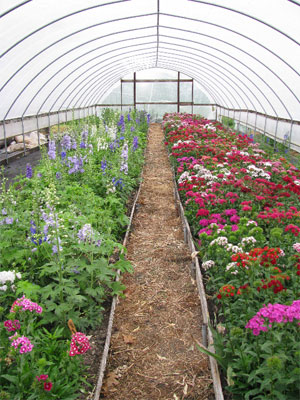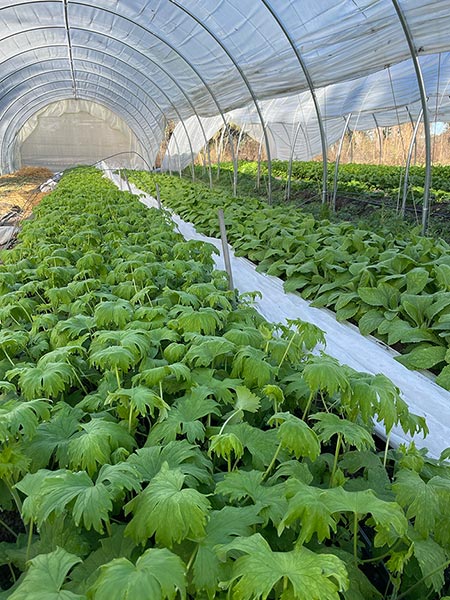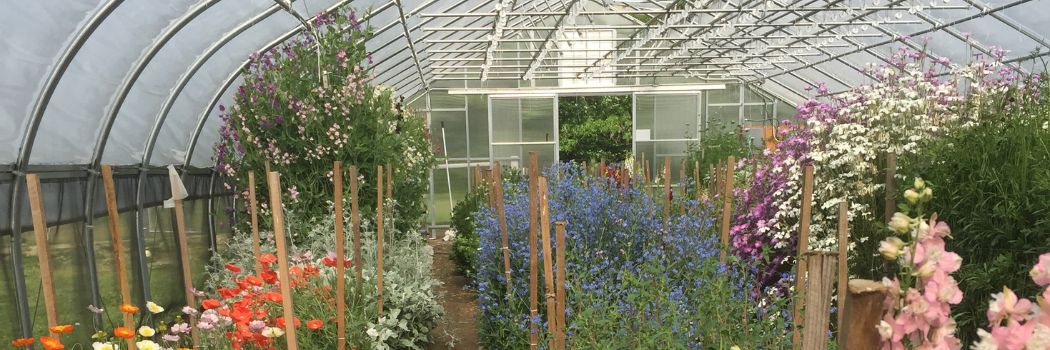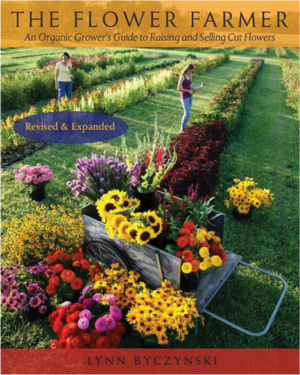- 3 Easy, Reliable, Productive Cut Flowers: Sunflowers, Zinnias & Rudbeckia
- 5 Factors That Determine Vase Life of Cut Flowers
- 2019 American Flowers Week: Combining the Art of Floral Design & Couture
- Celebrate the 7th American Flowers Week | Johnny's 2021 Botanical Couture
- Celebrating the 8th American Flowers Week | Johnny's 2022 Botanical Couture
- Collective Selling Models for Flower Farmers: Flower Hubs That Work
- 5 Cool Flowers to Plant Now | Lisa Mason Ziegler's Secrets for Growing Hardy, Cool-Season Annuals
- Cut-Flower Harvesting & Post-Harvest Care | Best Practices from Pros in the Slow Flower Community
- Cut-Flower Kit | Guide for Market Growers (PDF)
- Easy Cut-Flower Garden Map | For Growers New to Flowers (PDF)
- Easy Cut-Flower Garden Planner | For Growers New to Flowers (PDF)
- From Color to Climate: 5 Floricultural Trends Subtle & Seismic
- Flower Culture by Crop | Comparison Chart | Days to Germination, Weeks to Transplant, Days to Harvest (PDF)
- Flower Farmers' Favorite Fillers & Foliage | Recommendations from 3 Farmer-Florists
- Getting Started in Cut-Flowers | Top 15 Cuts
- Heat & Drought: How Flower Farmers Are Adapting to Changing & Challenging Climatic Conditions
- Introduction to Overwintering Flowers | Guide to Overwintering Flowers
- An Introduction to Producer Marketing Cooperatives | M Lund & Associates
- How Day Length Affects Cut-Flower Production
- Growing Flowers in Hoophouses & High Tunnels: Cool-Weather & Hot-Weather Options
- Starting a U-Pick Flower Farm, From A-to-Z
- Growing Flower Seedlings for Profit
- Roadside Flower Stand Basics: Success Tips for On-Farm Retail
- Year-Round Flower Production Strategy
- Overwinter Flower Trials | Multiyear Results for 30+ Crops | Johnny's Selected Seeds | XLSX
- Seeding Date Calculator | Johnny's Recommended Flowers for Overwintering | XLSX
- Pricing & Profitability for Flower-Farmers | Pointers from a Diversity of Pros
- Sustainable Farming Methods | A Survey of Flower Farmers' Best Practices
- Just Add Flowers | An Introduction to Companion Planting for Vegetable & Herb Gardeners
- Slow Flowers Palette & Petal Crushes | Evolving Colors & Shape-Shifts in Floral Industry Trends
- Johnny's and Slow Flowers | Johnny's Selected Seeds
- Slow Flowers | Celebrating Fifth-Season Regional Design Elements
- Slow Flowers Floral Forecast | A Summary of Industry Insights & Trends
- Building a Better Market Bouquet: Tips, Techniques & Recipes for Flower Farmers
- Slow Flowers | Tips for Staging On-Farm Floral Workshops | Johnny's Selected Seeds
- Wedding Wisdom 101 | 10 Beginner Tips for Entering the Wedding Floral Landscape
- Succession-Planting Flowers | Scheduling & Planning, Sowing Frequency, Recordkeeping & Recommendations
- Succession-Planting Interval Chart for Flowers
- Sustainable Floral Design | Techniques & Mechanics for Foam-Free Floristry | Tobey Nelson & Debra Prinzing
- Video: Mason Jar Bouquet Tutorial
- Video: How to Build a Bouquet
- Video: Tobey Nelson | Sustainable Floral Design | Slow Flowers Summit
- Video: Economic Considerations in Overwintering Cut Flowers | Johnny's Selected Seeds
- Top 10 Cut-Flower Varieties for Direct Seeding
- Video: Floating Row Cover | Baby "Cool Flower" Protection from Whipping Winter Winds
- Video: The Procona System for All-in-one Flower Harvest, Transport & Display
- Johnny's Overwinter Flowers Tunnel: Trellising, Supports, Ground Cover & Spacing
- Video: Irrigation Considerations for the Overwinter Flowers Tunnel | Johnny's Selected Seeds
- Video: Johnny's Overwinter Flowers Trial Recap
- Video: Producer Cooperatives for Small-Scale Farmers | Johnny's Webinar Series
- Climate Adaptation for Vegetable & Flower Farmers | Johnny's Educational Webinar Resources
- Chrysal CVBN Flower Conditioner | SDS
- Webinar Slide Deck | New-for-2023 Flowers & Floral Supplies | PDF
- Chrysal Clear Bulb Flower Conditioner | SDS
- Chrysal Professional 2 Transport & Display T-Bag | SDS
- Chrysal Classic Professional 2 Transport & Display (Holding) Solution | SDS
- Chrysal Clear Universal Flower Conditioner | SDS
- Webinar Slide Deck | Flower Growing in Southern States | PDF
- Choosing Flower Crops to Overwinter | Guide to Overwintering Flowers
- Edible Flowers List: Top 20 Favorites from the Slow Flowers Community
- Floral Standards for Flower Farm Collectives and Cooperatives
- Bloom to Boom: Flower Farm Profitability
- Choosing Tulip Varieties for Forcing | Guide to Forcing Flower Bulbs
- Forcing Tulip Bulbs | Guide to Forcing Flower Bulbs
- Snapdragon Groups Explained
- Flowering in the South: Profiles of 5 flower farmers who cope with temperature, humidity, pest & weed pressure
- Video: Flower Growing in Southern States | Johnny's Webinar Series
- 10 Tips for Building a Profitable Cut-Flower Business
- Introduction to Forcing Flower Bulbs in Soil | Guide to Forcing Flower Bulbs
- U-Pick Power for Your Flower Farm | Johnny's Webinar Series
- Eat Your Flowers: Serve Up That Wow Factor With Edible Flowers
- U-Pick Power for Your Flower Farm | Johnny's Webinar Series
- Flower Growing in Southern States | Johnny's Educational Webinar Series
- Chrysal Clear Bulb T-Bag | Cut-Flower Conditioner | SDS
- Chrysal Professional 1 Hydration Solution | SDS
- Chrysal Professional 3 Vase Solution Powder | SDS
- When to Start Seeds for Overwintered Flowers | Guide to Overwintering Flowers
- Webinar Slide Deck | U-Pick Power for Your Flower Farm | PDF

Lynn Byczynski was growing organic vegetables and cut flowers for market when she decided to create a magazine that would help market gardeners nationwide share experiences and information. Her first issue of Growing for Market appeared in January 1992, and GFM has been published continuously ever since, becoming renowned in the market-gardening world for realistic articles that provide practical, how-to information about growing and selling produce and flowers.
Cut flowers are one of the most profitable crops to grow in the unheated greenhouse (hoophouse or high tunnel). The minimal protection of an unheated hoophouse brings a wide range of benefits: excellent flower quality, longer stems, fewer pests, and a much longer season of harvest.
The best varieties to grow in a hoophouse depends somewhat on your latitude and regional climate. You should use the valuable space inside a hoophouse for crops that won't do well outside or those you can't grow outside at all because of wind or late frosts.
The key to successful hoophouse production of cut flowers is to experiment. Your climate and markets will dictate the best varieties for your situation. Here are some basic guidelines to consider in choosing the best crops for your hoophouse.
Cool Weather

In the South and in mild coastal areas, some cool-loving flowers will grow all winter without adding heat to the hoophouse. In colder areas, the hoophouse provides just enough protection to grow these varieties very early in spring or later in fall than usual. Daylength may limit blooming for some varieties, but even flowers that won't bloom in the short days of winter can put on significant growth and be ready to send up stems as soon as the days get longer. Day-neutral flowers will bloom as long as the temperature is acceptable. Some of the top crops for hoophouse production in cool weather:
- Anemones, Dutch iris, freesias, and ranunculus are high-value cut flowers, grown from bulbs or corms. Tulips and narcissus can also fetch a handsome price, especially when they are of premium quality, less common varieties, and brought into bloom early.
- Ammi majus, bupleurum, campanula, delphinium, dianthus, digitalis, larkspur, lupine, snapdragon, stock, and sweet peas are seed-grown flowers that love cool weather.
- Single-stem sunflowers are a great crop for early spring, late fall, and even winter in mild areas. Grow day-neutral varieties such as the 'Sun' Series, plant them closely, and replant every two weeks for a long harvest season.
Hot Weather

It may get too hot for human comfort inside a hoophouse in summer, but some flower varieties can take the heat and even thrive on it. Be sure to provide as much ventilation as possible, such as by removing end walls, so that the hoophouse cools off at night. And pay attention to the plants' water needs they may require more frequent irrigation inside the hoophouse than in the field. Don't plant varieties that are prone to foliar diseases because the relatively still air inside the hoophouse may worsen the problem. Zinnias, for example, are more prone to problems inside than outside.
- In areas where summers get extremely hot, the best flowers for the hoophouse are celosia, lisianthus, and ornamental peppers.
- At higher latitudes, however, most summer flowers can be grown in a hoophouse. Delphinium, for example, will bloom repeatedly throughout the summer in a hoophouse.
- Lilies, too, can be planted sequentially for a long season of harvest.
- Annual dianthus such as those in the 'Amazon Neon' Series can be succession-planted for several flushes of flowers.
Learn More
- Forcing Flower Bulbs
- Introduction to Forcing Flower Bulbs in Soil• Article
- Calculator - Bloom Date & Chilling Date for Forced Tulips• Calculator (XLXS)
- Forcing Tulip Bulbs• Article
- Choosing Tulip Varieties for Forcing• Article
- Overwintering Flowers
- Introduction to Overwintering Flowers: Methods & Recommendations from Johnny’s Multiyear Trials• Article
- Choosing Flower Crops to Overwinter: Results from Our Trials• Article
- When to Start Seeds for Overwintered Flowers• Article
- Overwintering Flowers • How to extend your growing season with cold-hardy annuals • Webinar Resources
- Overwinter Flower Trials • Results by Crop • Worksheet (XLSX)
- Overwinter Flower Trials • Seeding Date Calculator • Worksheet (XLSX)
- Heat & Drought



